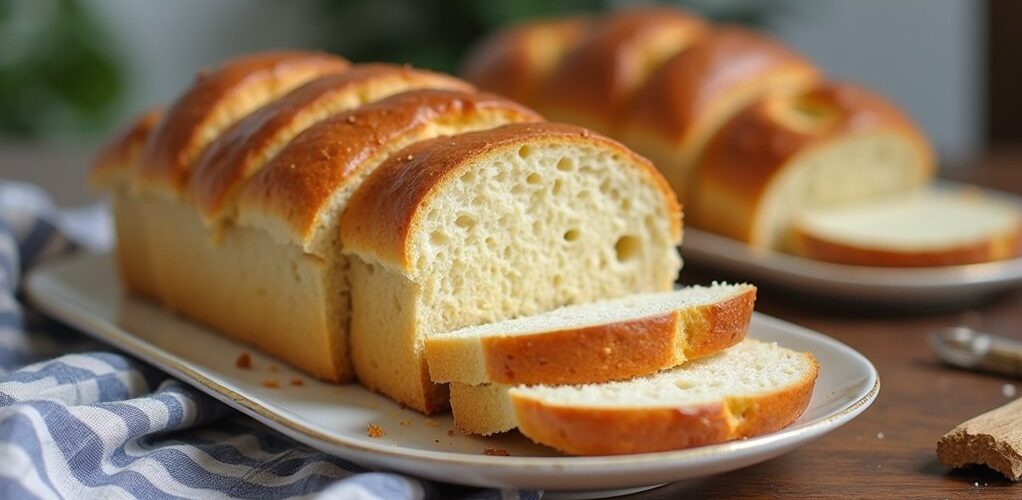
Many keto bread products, despite being marketed as low-carb, can contain hidden ingredients that impact blood sugar levels and disrupt ketosis. Manufacturers often manipulate net carb calculations by including questionable fiber sources like tapioca fiber or modified starches. Consumers should carefully examine ingredient lists, focusing on products with simple, whole-food components like almond flour and psyllium husk. Understanding key ingredients and proper label analysis reveals which keto breads truly align with low-carb goals.
Key Takeaways
- Some keto bread products contain hidden carbohydrates like modified wheat starch and tapioca fiber that can impact blood sugar levels.
- Net carb calculations can be misleading, as certain fibers still affect blood sugar despite being excluded from the total count.
- Examine ingredient lists carefully, prioritizing products with simple ingredients like almond flour and psyllium husk over complex additives.
- Compare serving sizes across different brands, as varying portions can significantly affect the actual carbohydrate content consumed.
- Look beyond marketing claims of "zero net carbs" and verify ingredients, as manufacturers may manipulate labels while maintaining high total carbs.
Understanding Net Carbs Vs Total Carbs in Keto Bread
When maneuvering the world of keto bread products, understanding the distinction between net carbs and total carbs becomes vital for maintaining ketosis. While many low-carb bread options advertise minimal net carbs, consumers must carefully examine both the nutrition facts and ingredient lists to verify these claims. Net carbs are calculated by subtracting fiber and certain sugar alcohols from total carbs, but this calculation can be misleading in keto bread products. Ingredients like tapioca fiber and modified starch contribute to total carbs yet may not be reflected in net carb counts. Savvy consumers should scrutinize ingredient labels thoroughly, as some manufacturers manipulate high-fiber ingredients to create the appearance of "zero net carbs" while maintaining significant total carbohydrate content. This knowledge helps guarantee keto bread selections truly align with ketogenic dietary requirements. For those on a keto diet, it's crucial to avoid refined carbohydrates like white bread, which can disrupt ketosis.
Common Hidden Ingredients That Spike Blood Sugar
Several hidden ingredients in keto bread products can greatly impact blood sugar levels, despite claims of being low-carb friendly. Common culprits include modified wheat starch, tapioca fiber, and chickpea flour, which manufacturers often incorporate while still marketing their products as keto-compliant.
These ingredients can considerably affect the glycemic index of the bread, potentially disrupting ketosis and triggering cravings. Many brands attempt to offset higher carbohydrate counts by adding extra fiber sources like oat fiber, creating misleading net carb calculations. To maintain truly low-carb status, consumers should carefully examine ingredient lists for these problematic additions.
Selecting keto bread made with simple ingredients such as almond flour and psyllium husk typically provides a more reliable option for those following a ketogenic lifestyle. It is essential to recognize serving sizes on nutrition labels to ensure accurate nutrient tracking and prevent excessive carbohydrate consumption.
Comparing Popular Keto Bread Brands
Popular keto bread brands showcase significant variations in their net carb counts, ranging from ThinSlim's 0g to Carbonaut's 5g per slice, making ingredient examination essential for informed choices. While manufacturers highlight fiber content to reduce net carb calculations, consumers should scrutinize ingredient lists for hidden carbohydrate sources that could impact blood sugar levels. The quality of core ingredients, such as almond and coconut flour used in Julian Bakery's products, often indicates both the bread's nutritional value and its effectiveness in maintaining ketosis. Some keto bread options, like Carbonaut and Kiss my Keto, are noted for their favorable blood sugar control, which can be crucial for those monitoring their glucose levels.
Net Carbs Vs Ingredients
A careful examination of keto bread labels reveals a complex relationship between net carb calculations and ingredient quality. When evaluating low carb bread options, consumers must look beyond simple net carb numbers to assess the actual ingredients used. While some brands manipulate their net carb counts by adding extra fiber, the presence of high-glycemic ingredients can undermine keto diet goals.
| Brand | Net Carbs | Key Ingredients | Hidden Sugars | Keto-Friendly |
|---|---|---|---|---|
| Base Culture | 4g | Arrowroot Flour | No | Yes |
| Arnolds Keto | 1g | Modified Wheat Starch | Yes | No |
| Julian Bakery | 2g | Almond/Coconut Flour | No | Yes |
| Thin Slims | 0g | Modified Wheat | Yes | No |
| Nature's Harvest | 3g | Chickpea Flour | Yes | No |
Hidden Sources of Carbohydrates
Understanding hidden carbohydrate sources in keto bread requires consumers to look beyond marketing claims and scrutinize ingredient lists carefully. Many products marketed as low in carbs contain ingredients that can impact blood sugar levels, such as modified wheat starch and oat fiber, despite their "keto-friendly" labels.
Common hidden sources of carbohydrates include tapioca fiber, chickpea flour, and arrowroot flour, which manufacturers may use to create gluten-free alternatives. While these ingredients can provide texture similar to traditional bread, they contribute to overall carbohydrate content.
Product comparisons reveal significant variations, with some brands containing as much as 28g of carbs per serving, while others maintain levels as low as 3g. Careful examination of ingredient lists helps consumers make informed choices about their keto bread selections.
Real Ingredient Quality Matters
Three key factors distinguish high-quality keto bread brands from their lower-quality counterparts: ingredient sourcing, processing methods, and nutrient density. When examining keto bread options, consumers should focus on products that use natural, low-carb ingredients like almond and coconut flour, while avoiding those with modified starches and hidden sugars.
| Ingredient Type | Quality Impact |
|---|---|
| Almond Flour | Nutrient-rich, naturally low carb |
| Arrowroot Flour | Moderate glycemic impact |
| Modified Wheat Starch | Can spike blood sugar |
| Essential Wheat Gluten | Affects true keto status |
| Tapioca Starch | Higher glycemic response |
Understanding net carbs versus total carbs becomes important, as some manufacturers artificially lower net carb counts through added fiber sources. Quality keto breads prioritize whole food ingredients over processed alternatives, ensuring better blood sugar management and authentic low-carb benefits.
The Truth About Fiber Content Claims
The complex relationship between fiber content and net carb calculations in keto bread products requires careful examination of nutrition labels and ingredient lists. While manufacturers often highlight fiber content to reduce net carb numbers, not all fiber sources contribute equally to blood sugar impact, with some derived from high-glycemic ingredients that can affect ketosis. Understanding the distinction between soluble and insoluble fibers, along with identifying hidden carb-heavy ingredients like tapioca starch or dextrin, becomes essential for consumers seeking genuinely low-carb bread options. Additionally, choosing keto-friendly sweeteners like stevia or erythritol can further help maintain ketosis by avoiding hidden sugars that may disrupt blood sugar stability.
Understanding Net Carb Math
Savvy shoppers frequently encounter misleading net carb calculations when steering through the world of keto-friendly bread products. Understanding how to properly calculate net carbs requires careful examination of both total carbohydrates and fiber content listed on nutrition labels.
While manufacturers may prominently display attractive net carb numbers, consumers must verify these claims by reviewing the complete ingredient list.
- Subtract fiber content from total carbohydrates to determine true net carbs
- Evaluate the source and quality of fiber ingredients, such as psyllium husk versus tapioca fiber
- Consider how specific fiber sources might affect blood sugar levels, despite net carb claims
Not all fiber sources are created equal in keto-friendly ingredients, and some may still impact blood glucose despite being excluded from net carb calculations.
This knowledge empowers consumers to make informed decisions about their low-carb bread choices.
Hidden Fiber Source Problems
Behind deceptive marketing claims about fiber content lies a complex web of ingredients that can undermine ketogenic dietary goals.
Many low-Carb bread manufacturers incorporate fiber sources like tapioca fiber and chicory root to reduce net carbs, but these ingredients can actually impact blood sugar levels differently than natural fibers.
Modified wheat starch and oat fiber present additional challenges, as these ingredients may contribute to the effective carbohydrate content despite being marketed as fiber-rich additions.
Understanding the distinction between soluble and insoluble fiber becomes essential, as not all fiber sources offer equivalent benefits for those following a ketogenic diet.
Careful examination of ingredient lists reveals that some manufacturers manipulate net carbs through the use of processed fiber sources that may not provide the same metabolic advantages as their natural counterparts.
Reading Beyond Marketing Claims
When food manufacturers market products as "keto-friendly" or "low-carb," consumers must look beyond these appealing claims to make informed decisions about their purchases.
A thorough examination of both ingredients and carbohydrate content reveals that many products contain high glycemic components that can impact blood sugar levels, despite their marketing claims.
To effectively evaluate keto-friendly products, consumers should focus on:
- Examining the complete ingredient list, not just the net carb count
- Comparing carbohydrate content across different brands of similar products
- Identifying quality ingredients with lower glycemic indices
Understanding product labels requires careful attention to detail, as manufacturers may use various techniques to manipulate carb counts. It's important to be cautious of hidden carbs, which can often be found in sauces, processed foods, and alcoholic beverages, as they may disrupt daily carb limits and affect ketosis.
For instance, the addition of specific fiber sources or the use of alternative flours can affect how the body processes these supposedly low-carb foods.
Key Ingredients to Watch For in Quality Keto Bread
Successful keto bread selection hinges on understanding the essential ingredients that distinguish quality low-carb options from their counterparts. When examining ingredients, consumers should prioritize products containing almond flour and psyllium husk, while avoiding those with modified starches and hidden sugars. The calculation of net carbs remains vital for maintaining ketosis. Incorporating sweetener options for keto baking like erythritol or monk fruit can enhance flavor without compromising carb counts.
| Ingredient | Benefits | Watch Out For |
|---|---|---|
| Almond Flour | Low in carbs, healthy fats | Proper storage needed |
| Psyllium Husk | Improves texture, fiber-rich | May affect moisture |
| Coconut Flour | Low-carb alternative | Dense texture |
Quality keto bread products should list these beneficial ingredients prominently while excluding high-glycemic additives like corn starch and rice flour, which can compromise ketogenic dietary goals. Careful label reading guarantees the best selection of truly low-carb bread options.
Making Smart Choices at the Store
Armed with knowledge about quality keto bread ingredients, shoppers can navigate store aisles with confidence to select the best low-carb options. Careful examination of the nutrition label reveals essential information about net carbs, calculated by subtracting dietary fiber from total carbohydrates.
Smart shoppers should scrutinize ingredients lists for wholesome components like almond flour and avoid products containing hidden high-glycemic additives.
- Compare serving sizes across different brands to accurately assess net carbs per portion
- Look beyond marketing claims and verify ingredient quality through detailed label analysis
- Check for clean, simple formulations that prioritize whole food components
When evaluating keto bread options, consumers must remain vigilant about misleading packaging claims and focus on substantiated nutritional information to make informed purchasing decisions. Incorporating healthy oils such as olive oil or avocado oil into keto bread recipes can enhance flavor and nutritional value while keeping carb counts low.
Frequently Asked Questions
Is Keto Bread Actually Low-Carb?
Keto bread's carb content analysis varies by ingredients. Nutritional label comparison reveals many products maintain low-carb status through fiber impact evaluation, though health benefits assessment depends on specific manufacturer formulations.
Is Aldi Keto Bread Really Carb Free?
Carb count verification reveals Aldi keto bread isn't carb-free. Product analysis shows approximately 20g carbohydrates per serving. Keto ingredient comparison and bread label scrutiny indicate modified starches affecting nutritional value assessment.
Is Franz Keto Bread Really Keto?
Franz keto bread contains ingredients consistent with keto standards, offering 3g net carbs per slice. Reviews indicate mixed satisfaction, while nutrition facts support keto claims. Alternative recipes often use almond flour-based ingredients.
Does Keto Bread Spike Insulin?
Keto bread's insulin response varies based on specific ingredients. While some utilize low glycemic index components and dietary fiber, others may contain ingredients that affect blood sugar levels differently among individuals.
Conclusion
When choosing keto bread products, careful label analysis remains essential for making informed decisions. While many brands market themselves as low-carb, examining net carbs, fiber content, and ingredient lists reveals significant variations in quality and metabolic impact. Consumers should focus on products with minimal processed ingredients, verified fiber sources, and transparent nutritional information. Understanding how to interpret these factors empowers shoppers to select truly keto-friendly bread options that align with their dietary goals.










No Comments